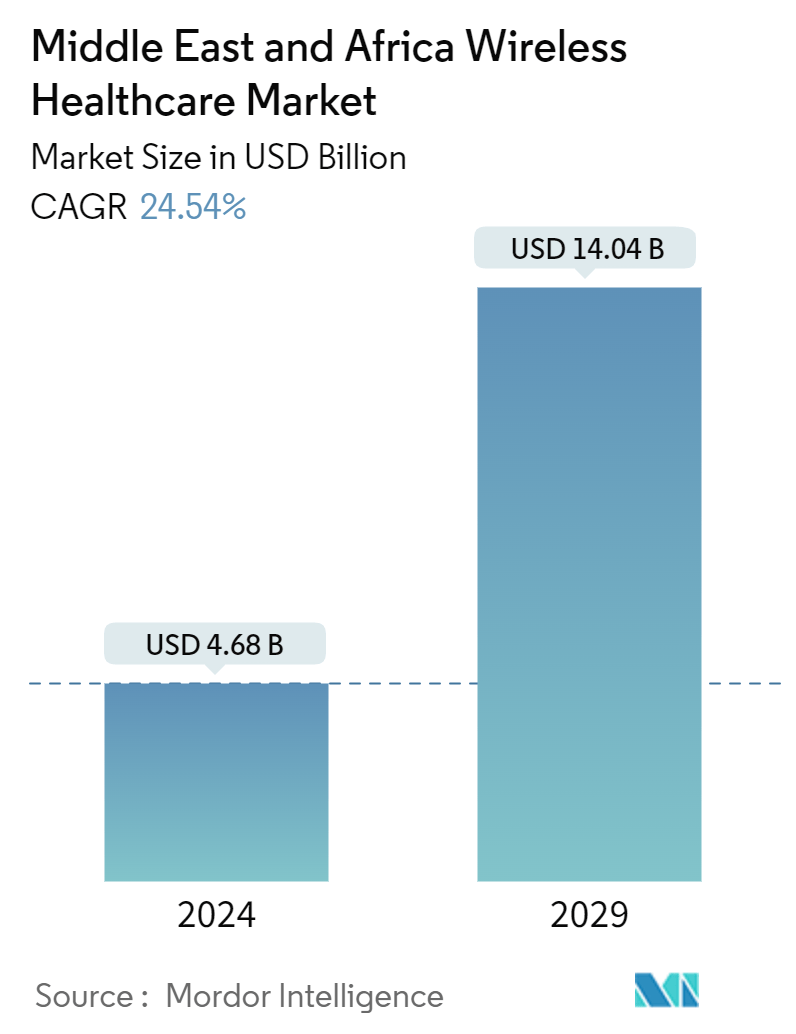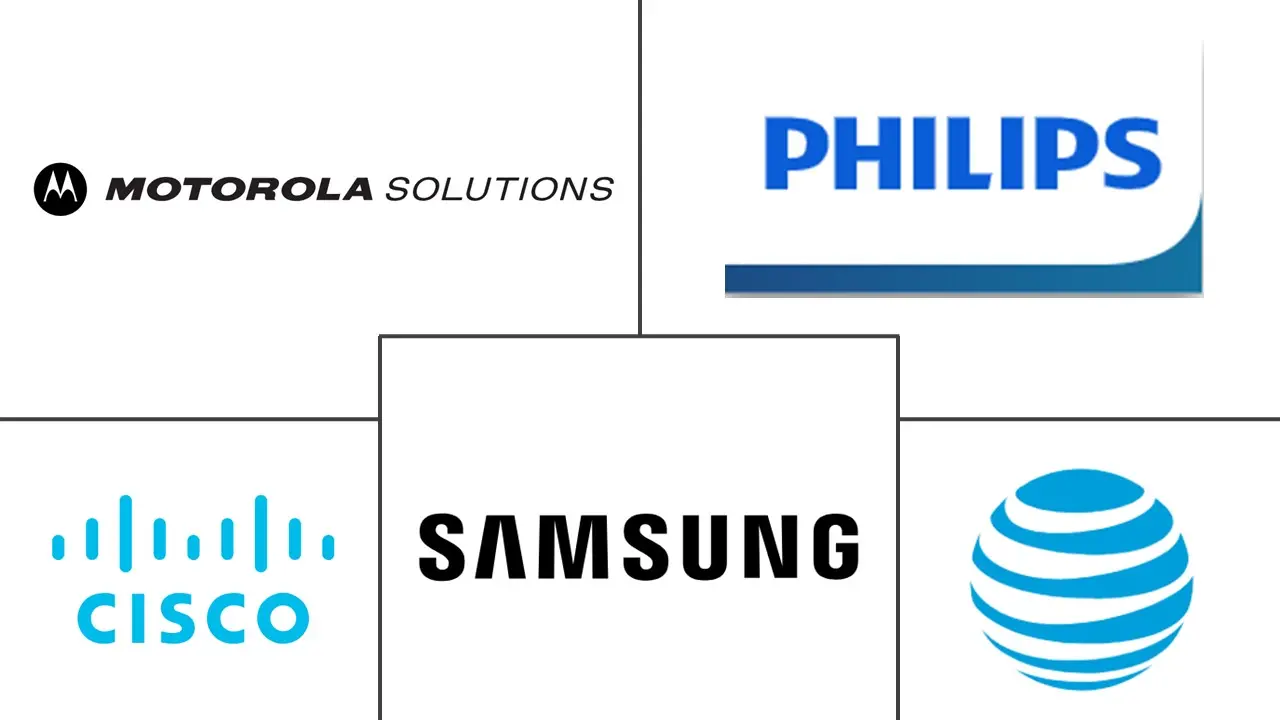Market Size of Middle East And Africa Wireless Healthcare Industry

| Study Period | 2019 - 2029 |
| Base Year For Estimation | 2023 |
| Market Size (2024) | USD 4.68 Billion |
| Market Size (2029) | USD 14.04 Billion |
| CAGR (2024 - 2029) | 24.54 % |
| Market Concentration | Low |
Major Players
*Disclaimer: Major Players sorted in no particular order |
Middle East & Africa Wireless Healthcare Market Analysis
The Middle East And Africa Wireless Healthcare Market size is estimated at USD 4.68 billion in 2024, and is expected to reach USD 14.04 billion by 2029, growing at a CAGR of 24.54% during the forecast period (2024-2029).
- The Middle East and Africa wireless healthcare market has experienced significant growth in recent years, driven by several factors, such as technological advancements, growing healthcare expenditures, and increasing adoption of digital health solutions.
- The prevalence of chronic diseases such as diabetes, cardiovascular diseases, and respiratory disorders is on the rise in the Middle East and Africa. Wireless healthcare technologies enable continuous monitoring of patient's health parameters, early detection of complications, and timely intervention, thereby improving patient outcomes.
- The increasing adoption of connected devices in healthcare is a significant driver propelling the growth of the wireless healthcare market in the Middle East and Africa. Connected devices such as wearable health trackers, smartwatches, and other sensor-based gadgets allow remote monitoring of patient's vital signs and health parameters.
- Growing technological advancements are driving the expansion of the wireless healthcare market in the region. Advancements in technology, such as the Internet of Things (IoT), artificial intelligence (AI), and wearable devices, enable the development of innovative wireless healthcare solutions. These solutions range from wearable health trackers and remote patient monitoring devices to telemedicine platforms and virtual health assistants.
- The lack of robust networking infrastructure poses a significant constraint to the growth of wireless healthcare in the market. Healthcare providers face challenges in transmitting patient data, conducting telemedicine consultations, and accessing cloud-based healthcare platforms essential for remote monitoring and management of patient's health.
- The COVID-19 pandemic prompted a surge in demand for remote healthcare solutions to minimize the risk of virus transmission in healthcare systems. Wireless healthcare technologies such as telemedicine platforms, remote patient monitoring devices, and mobile health applications experienced heightened adoption as patients sought virtual consultations and remote monitoring services.
Middle East & Africa Wireless Healthcare Industry Segmentation
Wireless healthcare incorporates wireless technology into traditional medicine, such as disease diagnosis, monitoring, and treatment, as well as additional technologies that can assist individuals in improving their health and wellness. Wireless healthcare ensures the accuracy of real-time documentation, lowers consumer expenses, offers access to real-time patient records, and enables real-time monitoring of patients' conditions even remotely.
The Middle East and Africa wireless healthcare market is segmented by component (hardware, software, and services), application (hospitals and nursing homes, home care, and pharmaceuticals), and country (Saudi Arabia, United Arab Emirates, South Africa, and Israel). The market sizes and forecasts are provided in terms of value (USD) for all the above segments.
| By Component | |
| Hardware | |
| Software | |
| Services |
| By Application | |
| Hospitals and Nursing Homes | |
| Home Care | |
| Pharmaceuticals |
| By Country | |
| Saudi Arabia | |
| United Arab Emirates | |
| South Africa | |
| Israel |
Middle East And Africa Wireless Healthcare Market Size Summary
The Middle East and Africa wireless healthcare market is poised for substantial growth, driven by technological advancements and increasing healthcare expenditures. The region is witnessing a rise in chronic diseases, necessitating the adoption of wireless healthcare technologies for continuous monitoring and timely interventions. The proliferation of connected devices, such as wearable health trackers and smartwatches, is enhancing remote patient monitoring capabilities, thereby improving patient outcomes. Despite challenges like inadequate networking infrastructure, the market is expanding due to the integration of IoT, AI, and telemedicine platforms, which are facilitating innovative healthcare solutions. The COVID-19 pandemic has further accelerated the adoption of these technologies, as remote healthcare solutions became essential to minimize virus transmission.
Saudi Arabia is at the forefront of this growth, with significant government investments in healthcare infrastructure and digital health initiatives under the Saudi Vision 2030 plan. The country's well-developed telecommunications infrastructure and high smartphone penetration rates create a conducive environment for wireless healthcare technologies. The home care application segment is particularly noteworthy, enabling remote monitoring and management of patients' health through mobile health apps and connected devices. Major players in the market, such as Cisco Systems Inc., Motorola Solutions Inc., and Koninklijke Philips NV, are enhancing their offerings through strategic partnerships and collaborations, further driving the market's expansion. These developments underscore the region's commitment to improving healthcare delivery and accessibility through digital transformation.
Middle East And Africa Wireless Healthcare Market Size - Table of Contents
-
1. MARKET DYNAMICS
-
1.1 Market Overview
-
1.2 Industry Value Chain Analysis
-
1.3 Industry Attractiveness - Porter's Five Forces Analysis
-
1.3.1 Bargaining Power of Suppliers
-
1.3.2 Bargaining Power of Consumers
-
1.3.3 Threat of New Entrants
-
1.3.4 Intensity of Competitive Rivalry
-
1.3.5 Threat of Substitute Products
-
-
1.4 Technology Snapshot
-
1.4.1 Wireless Personal Area Network (WPAN)
-
1.4.2 Wi-Fi
-
1.4.3 Worldwide Interoperability for Microwave Access (WiMAX)
-
1.4.4 Wireless Wide Area Network (WWAN)
-
-
1.5 Market Drivers
-
1.5.1 Increasing Adoption of Connected Devices in Healthcare
-
1.5.2 Growing Technological Advancements
-
-
1.6 Market Restraints
-
1.6.1 Lack of Networking Infrastructure
-
-
1.7 Assessment of COVID-19 impact on the Market
-
-
2. MARKET SEGMENTATION
-
2.1 By Component
-
2.1.1 Hardware
-
2.1.2 Software
-
2.1.3 Services
-
-
2.2 By Application
-
2.2.1 Hospitals and Nursing Homes
-
2.2.2 Home Care
-
2.2.3 Pharmaceuticals
-
-
2.3 By Country
-
2.3.1 Saudi Arabia
-
2.3.2 United Arab Emirates
-
2.3.3 South Africa
-
2.3.4 Israel
-
-
Middle East And Africa Wireless Healthcare Market Size FAQs
How big is the Middle East And Africa Wireless Healthcare Market?
The Middle East And Africa Wireless Healthcare Market size is expected to reach USD 4.68 billion in 2024 and grow at a CAGR of 24.54% to reach USD 14.04 billion by 2029.
What is the current Middle East And Africa Wireless Healthcare Market size?
In 2024, the Middle East And Africa Wireless Healthcare Market size is expected to reach USD 4.68 billion.

